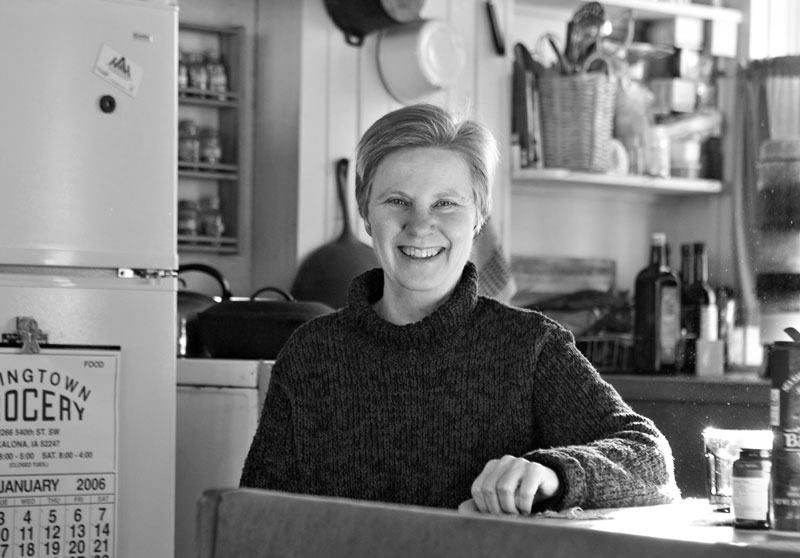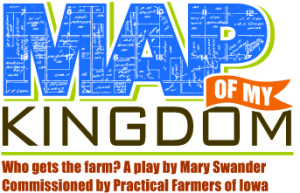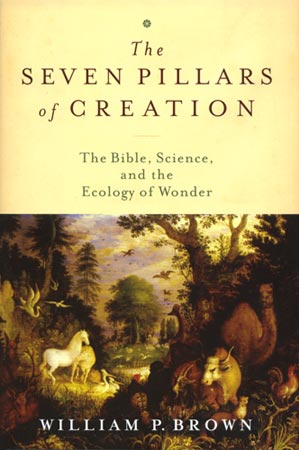I met Dave Robison at a talk he gave about cover crops to a farmers group in downtown Chicago. I was struck by his passion for his topic, his gracious way of interacting with the audience, and his gift for communicating complex information clearly and with humility. Many people came up to him afterwards with many questions, which he patiently answered for more than a half hour. This commitment is not new. For many years now, he has poured tremendous energy into sharing insights into this way of being a good steward of farmland. At one point, for instance, he made 51 presentations on cover crops in 50 days. And as you’ll see in this interview, he is a Christian who does what he does out of his faith. As way of background, Dave and his wife Sally have seven children and live in northeastern Indiana. Dave manages the alfalfa division of Legacy Seeds. The love, energy, and mission that come from his faith are palpable in his words. (To learn more about Dave and cover crops, visit his blog at www.plantcovercrops.com. Cover crops, by the way, are crops that farmers plant for land stewardship purposes – like preventing soil erosion, managing water, building soil fertility, creating better soil structure, and suppressing weeds. Uncovered soil is vulnerable to erosion, weeds, and a decline in soil vitality.)
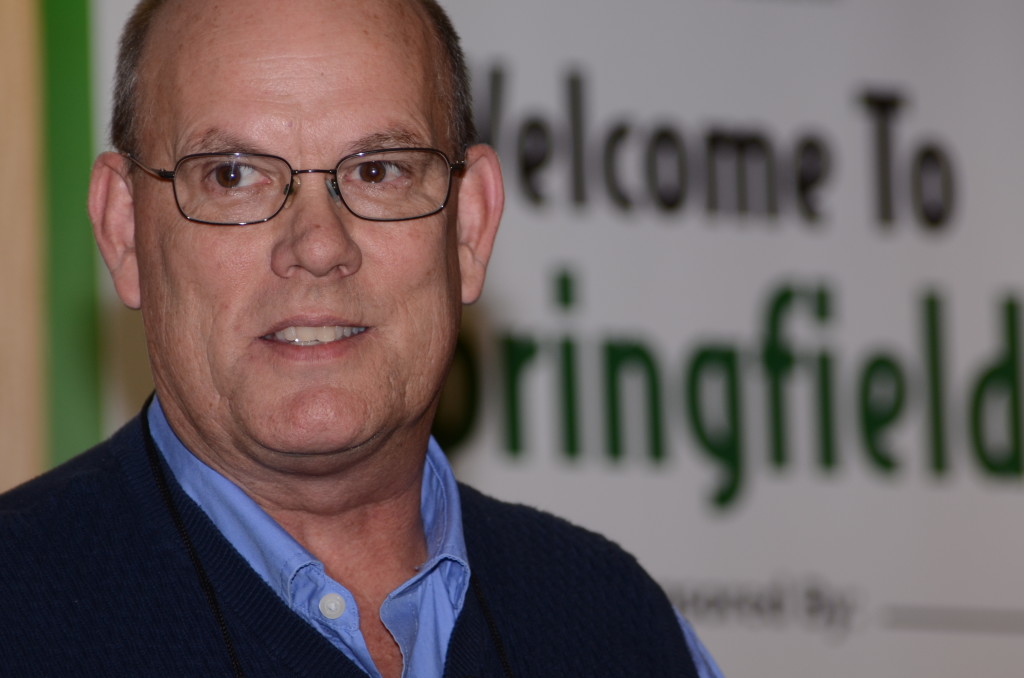
From your blog, I learned that you received a degree in agronomy from Purdue and that you were also the pastor of a country church for three years. That’s an interesting combination. Can you tell me a little about your life and your faith history?
DR: I graduated from Purdue in 1980. I got married right after college, and few months later, my wife got saved. In the church I was in, it was all about works and working my way to a relationship with God. My wife started spending a lot of time reading the Scriptures, obeying God’s Word, and I was seeing a real contrast between what I had grown up with and her life. Of course, I always thought she was wrong. (laughter) Then I began listening to Bible ministries of J. Vernon McGee and Chuck Swindoll and John McArthur and started having a better grasp of the Scriptures. I had taught Sunday school for years. I became chairman of the deacons, and there were 60 deacons in the church. I was chairman of committee on committees. So I was working hard to prove to myself, to my wife, to everybody that I was a Christian even though I had no relationship with Jesus. In 1989, nine years after my wife had been saved, I was listening to a sermon by Charles Stanley and it was just like, “I give up.” Salvation by grace through faith is the only way. So that day, as I was driving around Indianapolis on Highway 465, I gave my life to Christ and started crying. It was one of those Apostle Paul scales-falling-off-your-eyes kind of experiences. I had taught Sunday school for years, youth group for years. I was in some fairly high positions at the church, and then I got saved. A few months later I got baptized, which really sent reverberations around the church. What’s the chairman of the deacons doing getting baptized?
A couple years later, we felt called to the mission field, and both my wife and I went to Grace Theological Seminary. We got our masters of divinity at Grace, but during seminary we also had two more children so that now gave us four. We had school debt and farm debt and still owned a farm. So foreign missions was not going to work. But God brought the mission field to us in the fact that in the area where we live we have somewhere close to 10,000 Hispanic families. So about 12 years ago we started working with Hispanic families and sharing the Gospel. Most of that is with children and teenagers. There have been a number of families that have been saved and some teenagers that have been saved.
There’s been a remarkable difference in my life once Christ was truly Savior of my life, and I didn’t have to work to be saved.
So how does this tie in with your farming past and your cover crop work?
DR: We farmed for 11 years after we graduated from Purdue in 1980. In our first four years of farming (’80, ’81, ’82, ’83) we had two major weather events, and we had a mismanagement event. So all of sudden in those four years we had lost close to $90,000. We went from “This might work” to “This is really going to be hard.” So then I started working off the farm for a dairy farmer running a feed mill for him and that’s when I started learning about improved forages, especially improved alfalfa.
From a cover crop perspective, our family started no-till farming back in 1968. My father was very much one who wanted to take care of the soil but part of that was also out of convenience. We were growing rapidly, and we did not have massive equipment and did not have massive amounts of labor. It was my mom and dad and myself and my wife, and once the babies started coming, my wife was very helpful but she was a stay-at-home mom and taking care of babies. My mother had a bad back, and my dad worked full time at Eli Lily as a research scientist. So we, pretty much out of necessity continued to do a lot of no-till. Like a lot of pioneers in industries, we tried things that just flat out did not work.
But one year in the early 80’s we had a tremendous crop of sweet clover that came up volunteer (in the farming and land management world, “volunteer”refers to plants that appear without having been planted) on one of our farms. I guess the weather conditions had been just perfect over the winter. We ended up having corn that year that yielded almost 200 bushel an acre. That was way before other folks were getting 200-bushel-an-acre corn. The fellow that sprayed for us had a sprayer in the back of a pickup, and the sweet clover was taller than his boom. He ended up getting some mediocre kill. We ended up having to come back in and do some rescue spraying and so forth and he told us, “If you ever do that again I’ll never spray for you.” So we heard that message loud and clear. We also saw that we got 200 bushels per acre, but we didn’t put together that it was the sweet clover that gave us the improved yield so we never allowed for much growth in anything to be there in the spring again.
About seven or eight years ago as my father and I were talking about cover crops, I said, “Dad, do you remember the year at the one farm where we had sweet clover?” And he said, “That was the best corn we ever had.” And I said, “That’s because we followed a cover crop.”
To go back to the faith question and cover crops, I guess the biggest issue for us was no-tilling was convenient. But, for me, after I was saved, it became “You know what, this isn’t just convenience, this isn’t just farming. This is we have to be good stewards of what God has given us.” We would verbally say that but then it became something that was real when we started seeing the results of the experiments we were doing. We started experimenting on our home farm south of Indianapolis, and that’s when we started seeing quite a bit of difference in soil. Some of these soils have been no-till for 25 to 30 consecutive years, and we were seeing massive differences in our soil even after having cover crops for only one year.
Not that we worshipped the earth. We worship Christ. But we also realized then that we had a responsibility. It became a real issue for us when we found that we had compaction at about three inches deep on our farm, even though we had been no-tilling for so long. It was like, “Wow. We’re only farming an extremely shallow amount of soil here.” When we started using cover crops we started noticing that we were farming much deeper in the soil profile. I was on a farm then where we were having corn roots 70” deep. That’s really good for drought tolerance.
Back in 1979 I was in Fort Collins, Colorado, at a national public speaking contest for the American Society of Agronomy. The morning of the contest we were given a topic that we were to speak on, and my topic was on soil health, and I actually ended up winning the student sub-division of this national contest. I used an orange to compare the fact that we’re just farming the peel and even though the peel is the most nutritious part of the orange we typically don’t real good care of it. Therefore we need to do a better job of taking care of our layer of soil that God’s given us and that has the most nutrition.
I’ve thought many, many times over the years about the truth that God has given us the best part, but we have to take care of it and oftentimes we throw it away. We need to recognize that we have a responsibility not only to ourselves but also to future generations, a responsibility to take care of what God has given us. God’s called us to be responsible and good stewards, and we as farmers and as people involved in agriculture have some of the greatest responsibility.
How did you go from that insight to becoming a cover crop blogger and, to use the term loosely, evangelist?
DR: Back about six years ago I was working for a really awesome company out of Indiana as their forage manager and agronomist. I was in charge of alfalfa and forage sales and went all over the five-state region, especially Michigan and Indiana and Ohio, sharing about the value of improved forages and proper grazing techniques and how farmers could be much more profitable in their operations if they were managing well. I was invited to a field day at Purdue University’s southeast farm, and I was looking at the top growth of the winter rye and of the annual rye grass and the different wheat. They had dug soil pits, and I’m looking at all of this awesome feed that’s on top of the surface of the soil. It’s anywhere from knee high to waist high, and I’m thinking this will be fantastic for a dairy or a beef operation. Then we got into the root pit, and we were finding roots 35” deep on annual rye grass and the rye and the wheat about 20” deep.
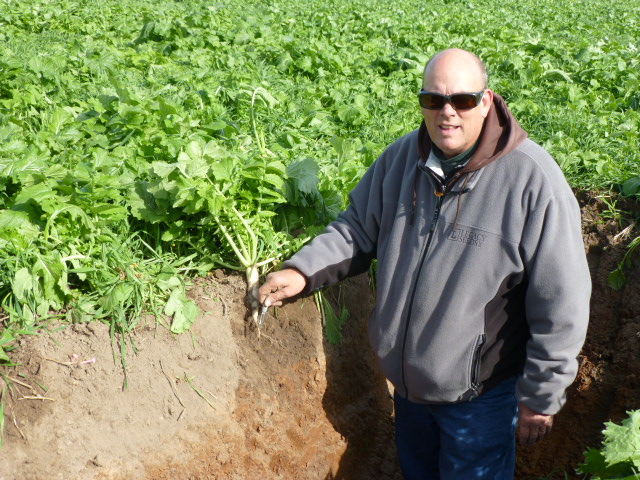
Dave in a root pit showing soil health impact of turnips used as cover crops.
Now I had already been doing some things about cover crops at that time, but I wasn’t thinking anything more than erosion control. Even with the experience with the sweet clover, I still wasn’t connecting everything yet. So I made a statement to Dr. Eileen Kladivko from Purdue who was running the field day. I said, “I really don’t care about what’s happening beneath the surface of the soil. All I care is about is what can be harvested on top. “ And as soon as I said that I realized that was contradictory to how I had farmed and also contradictory to what I had just seen. And everybody was like, “Whoa, I can’t believe you just said that!” I realized that my size-11 shoe was sideways in my mouth.
Two days later Eileen calls me and asks, “Would you be interested in being on the Midwest Cover Crop Council?” I agreed, went to a couple of meetings, and realized that this cover crop thing is vital to agriculture.
So then the company I worked for back in 2008 and 2009 was hit hard when the housing crisis hit. We took some pay cuts. I had already got pretty involved on the cover crop side and was already starting to promote our cover crops. I saw a huge need for our company to find another income source, but I also found that I was getting five to 10 phone calls per day from farmers saying, “Hey, I’m interested in these cover crops. Can you give me an hour?” That’s 10 hours in a day. So one of my best friends who worked at the same company said, “You know what? I’ve been looking into this stuff called blogging (of course, I had no idea what that was.). You write it. I’ll do some editing. And we’ll get it online, and maybe we can send people to the blog so you don’t have to spend so much time on the phone.”
So we did that and now we have about 80,000 people a year reading the blog, and somewhere around 3,000 people on the email list. And I probably get 20 emails a week from the blog that I try my best to answer. I speak all over North America on cover crops, especially the eastern half of the U.S. (Nebraska eastward) and in Ontario and Quebec. I don’t make money on that. It’s all volunteer.
The beautiful thing to me is that the company I got started with is now moving over 20 million pounds of cover crop seed per year. The company that is a kind of a sister company to them is moving somewhere around 10-15 million, and our company is moving 2-3 million. More and more farmers are recognizing the value of utilizing cover crops. From my perspective, if we can help farmers to be more profitable and do it in a very responsible way at the same time, then we’ve accomplished something outstanding for that family farm but also at the same time been good stewards of what God’s given us.
And I believe if it’s not going to be profitable for the farmer then the farmer’s going to be put into a situation where he’s going to have to say, “Well, I want to be a good steward, but…” And frankly I get a lot of those comments. There are a lot of times we do things that don’t pay, but this is one that I see a lot of people saying, “Well, if I’m not going to get my money back I’m not going to do it.” Which tells me that there are still a lot of farmers that aren’t understanding the stewardship issue yet.
What have you learned about God, people, and God’s earth from promoting cover crops and testing them?
DR: We have corn plants and soybean plants that when they hit a zone of compaction will take their roots horizontally. We have a little radish plant that might be the size of a pencil lead or an annual rye grass plant that is two inches tall or crimson clover that’s three inches tall that will get through that compaction zone. So in God’s Creation He has created different species of plants that have different characteristics that we can utilize that will help us to be able to best utilize our cash crops. God is not a God who deteriorates but is a God who renews. He has given us opportunities through his Son Christ to have a relationship with Him and a renewed spirit, a new life, and renewed hope. He has also given us, on the agricultural side, different species of different plants that help to better renew our soils and to better replenish our soils.
God, at least the God I see through Scripture, is one who always provides new hope, new life, new renewal, and man, because of sin, is one who deteriorates. That to me is a major theological foundation for us to understand that as we are stewards of what God has given us. He has given us the opportunity to renew some things that we have deteriorated, and some of those species of cover crops allow us to do that.
It’s interesting that Christians like Joel Salatin, Gabe Brown, and yourself are having a positive impact promoting sustainable farming practices.
DR: I think there are more. I know some other folks that are strong believers that are doing things on a local basis. Some of us are called to be, and I don’t know if I want to use this phrase, the Billy Grahams of the cover crop world. There’s no question that God has blessed Gabe and myself and Joel and a variety of other folks who are believers to be able to verbalize and communicate well and communicate with integrity. But there are a lot of Christians who do things on their local and regional basis.
I want to make sure I tell you about Zambia. A real good friend of mine that I worked with a lot took his family to Zambia. He is now an agricultural missionary. They are running a farm to feed the community, and they sell produce off of this farm and make money for the community. It’s been a fabulous ministry not only from an agricultural perspective but also for sharing Christ with this community. I got an email from him a couple of days ago, and he was thanking me for teaching him as much as I did about cover crops and for my blog and for my YouTube videos.
They are using cover crops in Zambia to be able to build their soil health. He said their farming yields and soil have improved tremendously since they started using cover crops. That made me say, “OK, God, this has been worth it over these 10 years now.” It was really interesting to me to hear a brother in Christ halfway around the world who is using training he got when he was in Fort Wayne, Indiana, to now be able to use those practices to help witness for Christ about not only soil health but spiritual health. What a blessing. When I got that email from him I got goose bumps.
What you do for a living, what I do for a living, for me it’s Colossians 3:17. “And whatever you do, whether in word or deed, do it all in the name of the Lord Jesus, giving thanks to God the Father through him.” Everything we do is for Christ.
Do your wife and your children get as excited about cover crops as you do?
DR: My wife does. In fact, I’ve called her the cover crop queen on my blog, because we have some relatively sandy and relatively poor soil on our property and she is always urging me to do something different. In fact, late last fall when I thought it was way, way too late to plant cover crops, she said, “Do you have any samples of seed?” And I said, “Well, yeah.” And she goes, “Well, I’m going to go out and plant cover crops.” The ground was nearly frozen. I’m like, “Honey, this just isn’t going to work.” She’s like, ”Well, remember when we planted radishes a few years ago when it was too late, and we ended up with a real nice radish crop in the spring? And how many earthworms were in my flowerbed?” “Yes,” I said. “Well,” she said, “we’re going to do that again.” So she planted cover crops really late, and now we have a really beautiful crop of hairy vetch that’s survived the winter and is looking beautiful in our flowerbeds, and it is producing nitrogen.
All of my children recognize the value of stewardship, whether that be stewardship of our soil or taking care of our brothers and sisters or of taking care of the needy. We want to make sure our children see that giving is better than receiving. Again, it’s all about Colossians 3:17.
